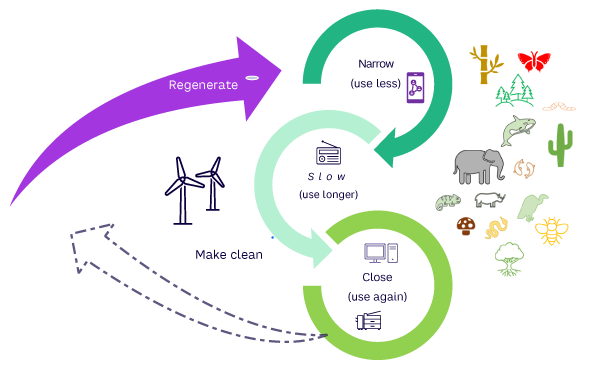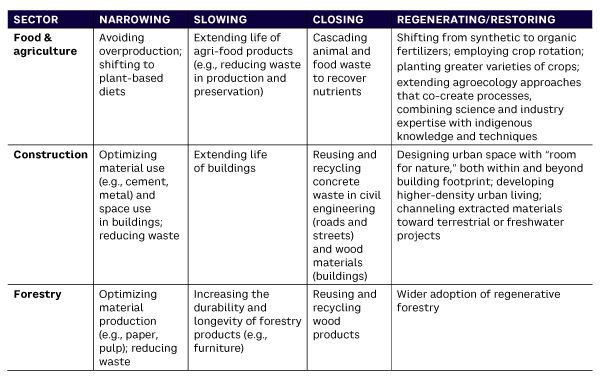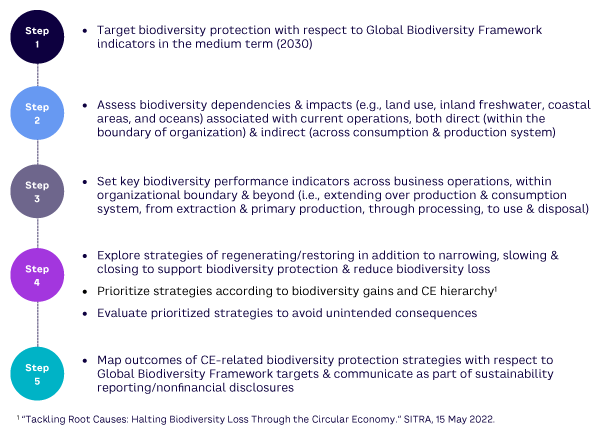AMPLIFY VOL. 36, NO. 3

Humans need to acquire resources from nature to survive, but our consumption has become unsustainable. This overconsumption not only deprives future generations, it means that resources have become scarce for other species. In fact, human consumption and production patterns have already put pressure on (or caused the extinction of) other life forms.1
It is time to rethink our human-focused approach to the natural environment and our indiscriminate use of nature’s resources.
This article discusses ways to reduce biodiversity loss using principles related to the circular economy (CE). Although CE is no panacea, we believe it has a role to play in reducing resource throughput and protecting biodiversity.
Avoiding the Biodiversity Blind Spot in the Circular Economy
CE has recently been promoted as an alternative economic model that supports national and regional agendas for recovery, renewal, resilience, inclusiveness, equality, and sustainability in a post-pandemic world. Its principles include designing out waste and pollution, keeping high-value products and materials in use, and regenerating natural systems (see Figure 1).2

Strategies for circularity include:
-
Narrowing resource loops by reducing resource intensity and optimizing resources. For example, the smartphone replaced cameras, phones, calculators, game consoles, and even computers.
-
Slowing resource loops through prolonging and intensifying product use. For example, products like computers and electronic appliances could be designed to be more durable for longer use.
-
Closing resource loops by replacing virgin materials with reuse, recycling, remanufacturing, and resource cascading. For example, computer and copier components could be reused within modular systems.
-
Regenerating/restoring resources by preserving and enhancing natural capital. Renewable energy systems are a good example.
Adoption of the CE model has been slow, but changing norms, increasing knowledge, and new incentives and financing are starting to drive CE-related implementations across major industries and large, influential companies.3 These organizations are mostly headquartered in the more economically developed regions of the world.
Various communities of practice worry that this transition to a broader circular economy is taking place too quickly, that governments and organizations may be so enthusiastic that they are not paying enough attention to the unintended consequences of CE actions. Indeed, history is littered with policies and strategies that had unintended consequences. Sometimes these responses have led to even more difficult-to-tackle problems; local and regional air pollution is a well-documented example.
We (and other voices) have aired concerns about wider environmental and social sustainability factors being neglected in CE-related thinking.4,5,6 A crucial blind spot relates to biodiversity.
Biodiversity refers to the variety and abundance of life on Earth; it includes genetic diversity within species, diversity between species, and diversity of ecosystems. The December 2022 United Nations Convention on Biological Diversity (COP 15) drew attention to the need for urgent action, without which “there will be a further acceleration in the global rate of species extinction, which is already at least tens to hundreds of times higher than it has averaged over the past 10 million years.”7
The resulting Kunming-Montreal Global Biodiversity Framework includes targets to conserve and restore biodiversity. It commits to protect at least 30% of the Earth’s lands, inland waters, coastal areas, and oceans by 2030. It is a significant call to arms around conservation efforts, one that has been recognized and endorsed by scientific communities such as the Half-Earth project, which is dedicated to the protection of biodiversity.8
Progress toward biodiversity targets is inextricably linked to changes in consumption and production. Through their global value chains, the negative biodiversity impact of multinational corporation operations extends far and wide across these systems. The World Bank estimates that 90% of total biodiversity loss can be associated with the management of resources within consumption and production systems.9
This begs the question: could strategies based on CE-related thinking support the goals of the Global Biodiversity Framework? The short answer is yes. However, we can neither assume that CE-related actions will not hinder biodiversity goals (or other environmental or social goals) nor expect that integrating biodiversity into company strategies and operations will be simple.10
Pros & Cons of CE Practices for Biodiversity Protection
There has been a recent flurry of activity exploring the relationship between CE and biodiversity. The Global Alliance on Circular Economy and Resource Efficiency (GACERE) is a UN Environment Programme initiative involving governments, businesses, and nongovernmental organizations. Its 2022 working paper on circular economy and biodiversity lays bare the evidence on biodiversity loss, its drivers, and its impacts on society and the economy.11 It also considers how CE-related actions could help reduce biodiversity loss and restore ecosystems.
The study emphasizes the hitherto neglected restorative and regenerative practices of circular actions. To date, many circular actions have been directed at keeping products and materials in circulation through reuse, repair, refurbish, remanufacture, and recycle.12
GACERE is not alone in calling for circular thinking among government and business to take biodiversity into account. In 2022, Finnish innovation fund SITRA published a study analyzing and quantifying CE’s role in halting biodiversity loss.13 Both GACERE and SITRA focus on sectors where circular actions have the largest biodiversity impacts: food and agriculture, construction, and forestry. These industrial sectors influence biodiversity through habitat loss and fragmentation, land degradation, materials extraction, and pollution to land and waterways.
Take the construction sector, for example. It is well known for its high environmental impacts, not least as the principal user of cement, the production of which accounts for around 5% of global carbon dioxide (CO2) emissions.14 CE actions would certainly help mitigate climate change, both through slowing and closing strategies that keep materials and minerals in circulation and from regenerative strategies that make greater use of renewable energy.
The biodiversity impacts of construction are just as pernicious. Its operations reduce and fragment natural habitats, relying on the extraction of raw materials (aggregates, wood, metals, etc.); its products directly occupy land (buildings, roads, pathways, etc.); and its waste requires land for treatment and disposal. Implementing circular strategies to avoid these land-use impacts is essential for preventing further biodiversity loss and rebuilding natural capital.
Table 1 summarizes some of the actions related to strategies within construction and other leading sectors that can reduce biodiversity loss and restore ecosystems. Interested readers can find more details in the reports and articles of GACERE,15 SITRA,16 Enni Ruokamo and her colleagues (who studied the potential of CE in the construction and forestry sectors to mitigate pressures on biodiversity in Finland),17 and Juan Velasco-Munoz and his colleagues (who studied CE implementation in the agricultural sector).18

It is worth noting that these strategies sometimes overlap. For example, slowing and closing implicitly involve narrowing; some closing strategies are inherently regenerative (e.g., cascading organic material to be used as fertilizers).
Not all circular actions benefit biodiversity. For example, material-selection choices that shift from nonrenewable materials to biomass (especially in the construction and forestry sectors, but also bioplastics in the consumer goods sector) and actions that substitute nonrenewable energy sources for bioenergy can affect land use and threaten biodiversity. Similarly, CE regenerative practices involving renewable energy technologies that use significant rare earth elements result in environmental issues stemming from mining and extraction.
Global CE efforts sometimes send materials to developing nations that may not have appropriate infrastructure and cause damage to local ecosystems. The CE model has also been criticized for encouraging economic growth that is not sustainable, triggering a rebound effect where more resources are used because of greater consumption due to less guilt in causing environmental burdens.
In a previous Amplify article, we introduced the concept of “strong” and “weak” sustainability models for CE.19 A strongly sustainable CE can support biodiversity; a weakly sustainable one can hurt it.
Implementing Circular Strategies for Biodiversity Protection
The Kunming-Montreal Global Biodiversity Framework is based on a theory of change involving government, business, and society to “determine priorities, allocate financial and other resources, internalize the value of nature and recognize the cost of inaction.”20
Although food and agriculture, construction, and forestry are in the vanguard, transformation of the sort demanded by the Global Biodiversity Framework requires that all organizations (large and small, private and public) contribute their “fair share.” Figure 2 outlines an underlying process through which an organization from any sector can assess and report on the relationship between circular strategies and actions that protect biodiversity.

Using science-based targets can help organizations demonstrate they are doing their fair share. The process shown in Figure 2 can be picked up by organizations and adapted to their context. When organizational sustainability strategies are developed, the roles of the many dimensions of environmental and social concerns must be carefully evaluated.
Organizations already complete various sustainability reports and materiality indices. Integrating CE and biodiversity initiatives and measures into current corporate and supply chain sustainability practices, systems, and data is necessary to realize the commitments of the Global Biodiversity Framework. In the next section, we identify some facilitating mechanisms to help organizations design circular strategies for biodiversity protection.
Facilitating Mechanisms
Robust strategies that protect biodiversity and contribute to wider sustainable development goals are optimal. Although the two challenges are often considered separately, pursuing CE strategies that protect biodiversity and have co-benefits for climate change mitigation and adaptation will get support from the broader policy and environmental advocate community. Performance evaluation and measurement approaches, evidence-based analysis, and supporting tools and technology for decision-making are all necessary to help organizations identify these environmental synergies. For example, regenerative farming and farm-to-farm trading in carbon credits can support carbon capture while encouraging more efficient farming practices and reducing the need for further farmland expansion.21
Significant IT support will be needed to manage these data-intensive efforts (requiring the potential capture of billions of pieces of information related to land use and carbon-capture savings) and to integrate stakeholder trading mechanisms and tools. The data must be reliable, traceable, transparent, and easily accessible. Without it, businesses, policy makers, and other stakeholders will never be convinced that achieving multiple goals is possible.
Stakeholder engagement in co-creating processes that combine science and industry expertise with indigenous knowledge and techniques is particularly important for biodiversity protection — but organizations must go further. In some of the most biodiverse regions of the world, native indigenous communities are the most likely to be affected when CE strategies are rolled out or scaled up.
Measures will be needed to afford these communities beneficial outcomes. At a minimum, stakeholder engagement should extend to training, knowledge development, and incentivization. Businesses, supply chains, and governments will need to effectively cooperate with various communities and representatives to make sure that negative consequences do not occur.
Conclusion
Reducing biodiversity loss is not enough; we must create conservation plans that regenerate habitats and restore degraded areas. Adoption of the Global Biodiversity Framework is an ambitious commitment to conservation. Achieving its goals relies on government, business, and society stepping up. Pursuing CE strategies that narrow, slow, close, and regenerate resources can be part of that coordinated response.
Ultimately, humans and their systems are part of the Earth’s biodiversity. Damaging ecosystems means damaging human systems. The Earth, in the long run, will not care what we do; humans are the ones that should care.
References
1 Leclère, David, et al. “Bending the Curve of Terrestrial Biodiversity Needs an Integrated Strategy.” Nature, 10 September 2020.
2 ”What Is a Circular Economy?” Ellen MacArthur Foundation, accessed March 2023.
3 “Squaring the Circle: Policies from Europe’s Circular Economy Transition.” The World Bank, 6 December 2022.
4 Dewick, Paul, et al. “The Puzzle of the Informal Economy and the Circular Economy.” Resources, Conservation and Recycling, Vol. 187, December 2022.
5 Korhonen, Jouni, Antero Honkasalo, and Jyri Seppälä. “Circular Economy: The Concept and Its Limitations.” Ecological Economics, Vol. 143, January 2018.
6 Sarkis, Joseph, et al. “Coordinating Circular & Degrowth Systems for Strong Sustainability.” Amplify, Vol. 1, No. 5, 2022.
7 ”Nations Adopt Four Goals, 23 Targets for 2030 in Landmark UN Biodiversity Agreement.” Press release, Convention on Biological Diversity, 19 December 2022.
8 The Half-Earth Project website, 2023.
9 The World Bank (see 3).
10 Buchmann-Duck, Johanna, and Karen F. Beazley. “An Urgent Call for Circular Economy Advocates to Acknowledge Its Limitations in Conserving Biodiversity.” Science of the Total Environment, Vol. 727, July 2020.
11 “Circular Economy and Biodiversity — Working Paper.” Global Alliance on Circular Economy and Resource Efficiency (GACERE), 2 March 2022.
12 ”The Butterfly Diagram: Visualising the Circular Economy.” Ellen MacArthur Foundation, accessed March 2023.
13 Forslund, Tim, et al. “Tackling Root Causes: Halting Biodiversity Loss Through the Circular Economy.” SITRA, 15 May 2022.
14 Global Carbon Project website, accessed March 2023.
15 GACERE (see 11).
16 SITRA (see 13).
17 Ruokamo, Enni, et al. “Exploring the Potential of Circular Economy to Mitigate Pressures on Biodiversity.” Global Environmental Change, Vol. 78, January 2023.
18 Velasco-Muñoz, Juan F., et al. “Circular Economy Implementation in the Agricultural Sector: Definition, Strategies and Indicators.” Resources, Conservation & Recycling, Vol. 170, July 2021.
19 Sarkis et al. (see 6).
20 “First Draft of the Post-2020 Global Biodiversity Framework.” UN Convention on Biological Diversity, 5 July 2021.
21 “Indigo Agriculture.” World Economic Forum, accessed March 2023.




